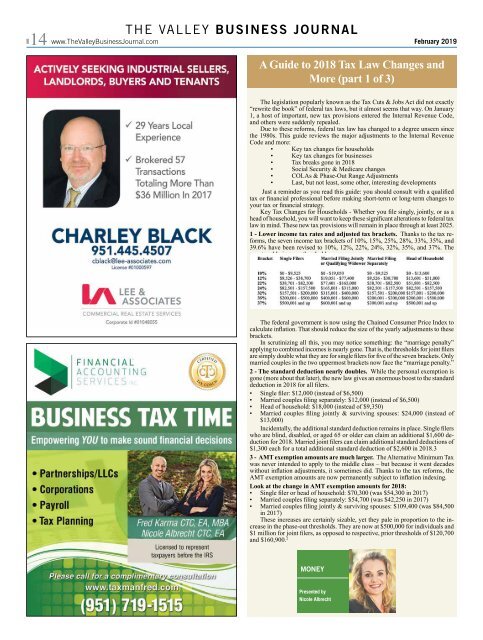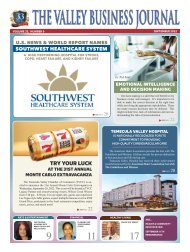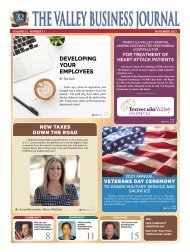VBJ February 19
Create successful ePaper yourself
Turn your PDF publications into a flip-book with our unique Google optimized e-Paper software.
THE VALLEY BUSINESS JOURNAL<br />
14 www.TheValleyBusinessJournal.com<br />
<strong>February</strong> 20<strong>19</strong><br />
A Guide to 2018 Tax Law Changes and<br />
More (part 1 of 3)<br />
The legislation popularly known as the Tax Cuts & Jobs Act did not exactly<br />
“rewrite the book” of federal tax laws, but it almost seems that way. On January<br />
1, a host of important, new tax provisions entered the Internal Revenue Code,<br />
and others were suddenly repealed.<br />
Due to these reforms, federal tax law has changed to a degree unseen since<br />
the <strong>19</strong>80s. This guide reviews the major adjustments to the Internal Revenue<br />
Code and more:<br />
• Key tax changes for households<br />
• Key tax changes for businesses<br />
• Tax breaks gone in 2018<br />
• Social Security & Medicare changes<br />
• COLAs & Phase-Out Range Adjustments<br />
• Last, but not least, some other, interesting developments<br />
Just a reminder as you read this guide: you should consult with a qualified<br />
tax or financial professional before making short-term or long-term changes to<br />
your tax or financial strategy.<br />
Key Tax Changes for Households - Whether you file singly, jointly, or as a<br />
head of household, you will want to keep these significant alterations to federal tax<br />
law in mind. These new tax provisions will remain in place through at least 2025.<br />
1 - Lower income tax rates and adjusted tax brackets. Thanks to the tax reforms,<br />
the seven income tax brackets of 10%, 15%, 25%, 28%, 33%, 35%, and<br />
39.6% have been revised to 10%, 12%, 22%, 24%, 32%, 35%, and 37%. The<br />
new taxable income thresholds:<br />
The federal government is now using the Chained Consumer Price Index to<br />
calculate inflation. That should reduce the size of the yearly adjustments to these<br />
brackets.<br />
In scrutinizing all this, you may notice something: the “marriage penalty”<br />
applying to combined incomes is nearly gone. That is, the thresholds for joint filers<br />
are simply double what they are for single filers for five of the seven brackets. Only<br />
married couples in the two uppermost brackets now face the “marriage penalty.”<br />
2 - The standard deduction nearly doubles. While the personal exemption is<br />
gone (more about that later), the new law gives an enormous boost to the standard<br />
deduction in 2018 for all filers.<br />
• Single filer: $12,000 (instead of $6,500)<br />
• Married couples filing separately: $12,000 (instead of $6,500)<br />
• Head of household: $18,000 (instead of $9,350)<br />
• Married couples filing jointly & surviving spouses: $24,000 (instead of<br />
$13,000)<br />
Incidentally, the additional standard deduction remains in place. Single filers<br />
who are blind, disabled, or aged 65 or older can claim an additional $1,600 deduction<br />
for 2018. Married joint filers can claim additional standard deductions of<br />
$1,300 each for a total additional standard deduction of $2,600 in 2018.3<br />
3 - AMT exemption amounts are much larger. The Alternative Minimum Tax<br />
was never intended to apply to the middle class – but because it went decades<br />
without inflation adjustments, it sometimes did. Thanks to the tax reforms, the<br />
AMT exemption amounts are now permanently subject to inflation indexing.<br />
Look at the change in AMT exemption amounts for 2018:<br />
• Single filer or head of household: $70,300 (was $54,300 in 2017)<br />
• Married couples filing separately: $54,700 (was $42,250 in 2017)<br />
• Married couples filing jointly & surviving spouses: $109,400 (was $84,500<br />
in 2017)<br />
These increases are certainly sizable, yet they pale in proportion to the increase<br />
in the phase-out thresholds. They are now at $500,000 for individuals and<br />
$1 million for joint filers, as opposed to respective, prior thresholds of $120,700<br />
and $160,900. 2<br />
MONEY<br />
Presented by<br />
Nicole Albrecht

















